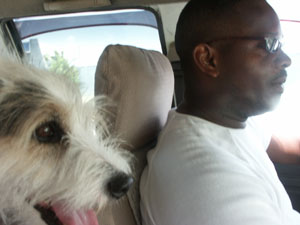 PORTOBELO
PORTOBELO
We took the first taxi that came by the yacht club. This
one had a small flat bed in the back as he was delivering whole chickens to the
back kitchen door at the yacht club. He was the chicken-truck-taxi. We
hopped in and it was evident the taxi driver didn’t know a word of English. Margie and Richard always got a taxi driver that was like a tour guide and spoke
English. In Panama, they had a guy named “Ephraim”. It was “Ephraim took us
here” and “Ephraim took us there.” Everything was Ephraim. When they got to
Colon, it was the taxi driver “Dracula”. Both of the taxi drivers were Tina’s
contacts and helped her do her errands. Richard would call them on the cell
phone and make arrangements. We get the chicken truck. We didn’t want a tour
we just wanted a ride. After all the problems that had been going on with the
crew situation, we just wanted to drive and in any direction away from the boat.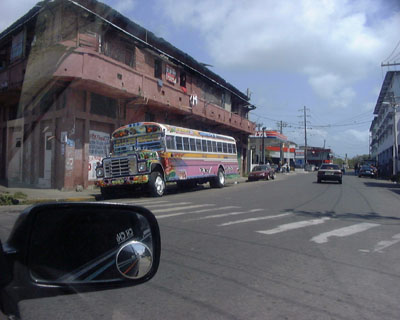
I asked him to drive a little around Colon so we could see it and then take us to Portobello. He drove us down the main street of Colon, which at one time might have been a little grand, no that’s pushing it; it was already a hellhole from what I’ve read. It’s just that there’s so much history here with the building of the canal that something could be done to preserve some of that. Unfortunately, it’s all passing away.
The town had a large boulevard running down the length of
it with grass and trees and an occasional statue. We passed many old colonial
buildings that were on their last legs but still occupied with people. It was
hard to appreciate any of the history here because it’s such a war zone and so
poverty struck. The majority of people were black. I’m assuming they are here
because their ancestors were from the slave trade and others were left over were
from the building of the canal. Many black were brought over from Antilles and
other areas. After that was done, there was no more work.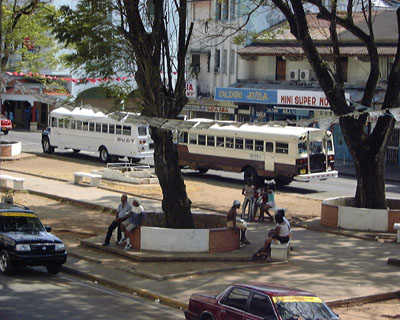
As we travel throughout Central America, The United Fruit Company developed many of the places we’ve been. Once that company left, the places were left with people like this, no jobs, and no place to go. This is part of the story here. Rains has a saying, “If you’re in Colon for a week, you’re mugged once, and if you’re in Colon for two weeks, you’re mugged twice.”
They are starting to bring cruise ships into this town to see what I can’t imagine. I’d be pretty upset if my cruise stopped here for a pleasure stop. The spell that we’ve been here the new Queen Mary 2 has been here.
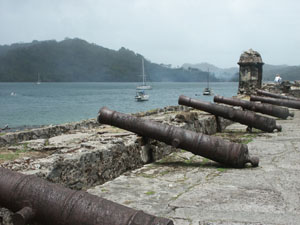 We headed down the highway towards Portobello. Once we got
far enough from the outskirts of Colon, we started to enjoy the countryside.
There were some ranches and cattle grazing in the grassy land. People would
walk along the narrow highway on the very edge and would barely be missed by the
passing cars. All the people were mainly black as it was other places we’ve
throughout Panama. Many of the women were walking carrying open umbrellas
shielding themselves from the heat of the sun.
We headed down the highway towards Portobello. Once we got
far enough from the outskirts of Colon, we started to enjoy the countryside.
There were some ranches and cattle grazing in the grassy land. People would
walk along the narrow highway on the very edge and would barely be missed by the
passing cars. All the people were mainly black as it was other places we’ve
throughout Panama. Many of the women were walking carrying open umbrellas
shielding themselves from the heat of the sun.
We crossed many beautiful streams emptying into the ocean.
The hills were covered with thick foliage and there were many tall spreading
trees with exotic birds. It was a pleasant scene to clear our minds. As we
drove, I couldn’t help thinking about the old days when this was a important
route for Spain as they would carrying millions in gold and silver from South
America, through the 85 mile route from Panama to Portobello on the backs of
thousands of mules. Then it was a long treacherous route with snakes, and
pirates to make their trek even more difficult. Illness and death was a common
part of life as they had to fear malaria and yellow fever. It was hard to
imagine that in this beautiful landscape.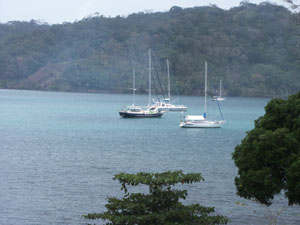
After about an hours drive, we came upon the first ruins of
the embattlement that the Spanish had built to protect their gold. It was a
fortress lined with an amazing number of canons pointed across the beautiful
natural harbor of Portobello. We got out of the car and walked through the
fortress and imagined the likes of Sir Francis Drake and Henry Morgan anchoring
in the bay and creating havoc on this town for the hopes of stealing the
millions in gold and silver. It was hard to imagine the bay filled with Old
Spanish galleons and pirate ships, as now it is a cruiser’s paradise. We looked
out to the small-protected bay and envied the few cruiser’s that were anchored.
The fortress was well preserved as Spain did a good job in recent years
restoring the area and spending quite a bit of money to do so. Although, I read
that many conservationists were upset because they cut into the natural coral
reef nearby to recreate building blocks from the brain coral to rebuild the
fortress thus irreparably damaging the reef. I read it will take hundreds of
years for the reef to recover and repair itself from the damage they did. The
Spaniards used the brain coral because it was strong and could be easily cut.
Because it was porous, it was lightweight and easy to handle. I would’ve never
thought that it was built from coral because it looked and felt like hard stone.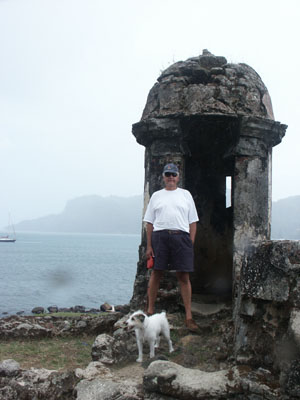
Gazing out into the beautiful small bay, I had wished that we could’ve brought the boat here and weathered the bad winds. It was so beautiful. It wasn’t covered in white caps today.
The town is small and very rustic. In the center are the old church, customs house, and another fortress. Surrounding these historic buildings is a small stream going by the fortress and aboriginal huts. As we walked the area, we saw the old dungeon rooms where they kept the prisoners and where it is said that Henry Morgan threw some Spaniards in there and blew it up. These fortresses were built to protect the millions in gold and silver that the Spanish took from the New Americas, like Peru and Mexico. The treasures were brought on the back of mules, as I mentioned, 85 miles through the jungle from Panama City to this spot. It was then counted and stored in the customs house until it was loaded onto the Spanish galleons and transported to Seville Spain. That is if it wasn’t stolen by some adventurous pirates before hand. With those millions you can begin to understand the lure to become a pirate.
CLICK ON ANY PICTURE
TO ENLARGE
|
[photogallery/photo11942/real.htm]
|
The two story Old Customs House is right next-door and has
been beautifully restored by Spain. To imagine that this small two story
building stored so much treasure and was so important to the survival of Spain.
The riches the Spaniards took from Mexico and Peru were melted down into gold
and silver bars in Panama and transported here. The idea was too much for the
likes of pirates. If they captured one of the many ships on it’s way to Spain,
that would be enough for each pirate to live like a king for the rest of his
life. This place was the downfall for the like of Sir Francis Drake though, as
his body was buried at sea at the mouth of the entrance.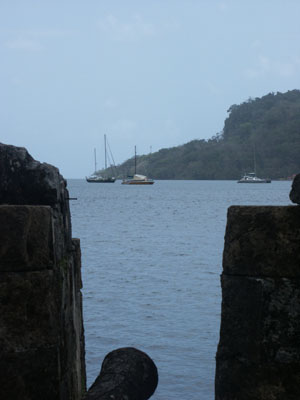
As we walked around the fortress, I was almost more interested in the huts nearby. The brown skinned occupants were living like they must have been living hundreds of years ago. The huts were roughly constructed on poles above the water with palm-thatched roofs. They were covered with laundry hanging outside and mud paths below. I’m sure whatever sewage they have just drops right down into the water below and washes out in the stream to the bay. There was no plumbing and I saw one woman tossing a bowl of water out the window. Their dugout canoes were stored underneath their huts. It was amazing to see these people right here just as they might have been back in the old days.
We walked through the old cathedral, Iglesia de San
Felipe, nearby. It was plain and unembellished except for it’ one famous
treasure and that is the Black Christ. There are many legends around this Black
Christ. There are tales of it being loaded on a ship headed for Cartagena, Columbia and each time the ship tried to leave the harbor, great storms would
force it back. The sailors as said to finally have tossed a box over the side
to lighten the load and once they did the storms abided and they were able to
leave. Some fishermen found the box and inside was the Black Christ.
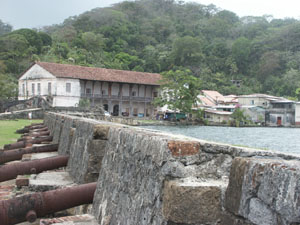
Another legend is that some fisherman came across the Black Christ floating in a box. They brought it to the town that at the time was stricken with Cholera. Once it was placed in the church the epidemic subsided.
Regardless, the people promise that the Black Christ will
never be removed from Portobello and annually have a celebration to honor the
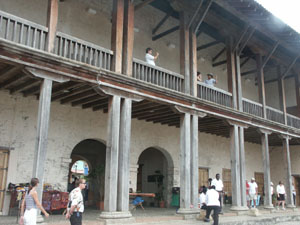 Black Christ as it is paraded through town, and is an excuse for partying,
drinking and gambling as I’m told.
Black Christ as it is paraded through town, and is an excuse for partying,
drinking and gambling as I’m told.
We had lunch with our taxi driver on a nice little
restaurant down the road overlooking the out harbor. It was a beautiful quiet
bay. We talked a bit with the taxi driver and found out he had a family and
children but that’s about all that I could understand because his Spanish was a
mix of Creole and other dialects that made it difficult.
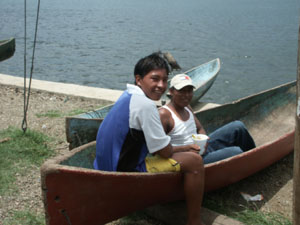
Though Larry didn’t get to anchor here we were happy to have been able to come and see it in the chicken-taxi truck.
Click here for Constipated in Colon.